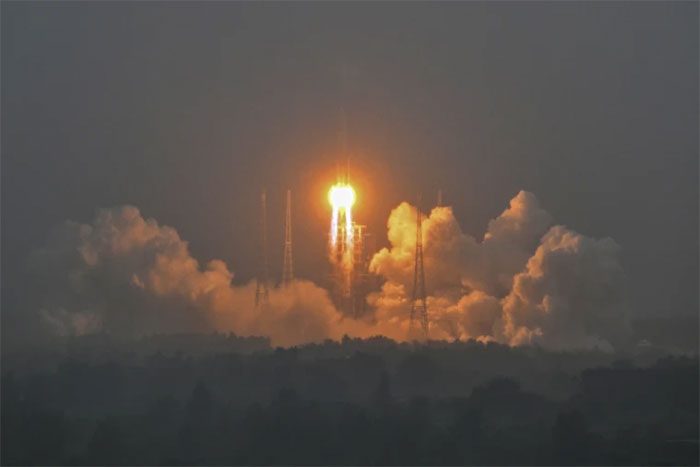China is returning to the mysterious far side of the Moon and bringing back some samples from its surface. The Chang’e 6 mission was launched on May 3, aboard a Long March rocket from the Wenchang Space Launch Site in Hainan province, southern China.
If everything goes according to plan, Chang’e 6 will reach the far side of the Moon, collect some samples, and return to Earth – a feat that has never been accomplished before.
The Hidden Face of the Moon
The Moon is tidally locked to Earth, completing one rotation in the same time it takes to orbit Earth. This means that observers on Earth can only see one side of the Moon – what we call the near side.

The Chang’e 6 mission has been launched to the Moon. (Image: NBC News).
Exploration missions or landers to the far side face communication challenges, requiring a lunar orbiter to relay information to and from mission control on Earth. China launched such a relay satellite, named Queqiao, prior to Chang’e 4 and sent another satellite, Queqiao 2, towards lunar orbit last March to prepare for Chang’e 6 and subsequent surface missions.
Scientists emphasize that the far side of the Moon is very different from the near side. For example, while vast basalt plains known as maria cover about one-third of the familiar surface of the Moon, these dark volcanic “seas” account for only 1% of the far side’s surface.
A Complex Mission
The Chang’e 6 mission consists of four components: a lunar orbiter, a lander, an ascender, and a return module.
If all goes according to plan, the lander (equipped with the ascender) will touch down inside the Apollo crater, part of the South Pole-Aitken Basin (SPA), one of the largest impact craters in the solar system. The SPA basin spans approximately 2,500 km, and its ancient rocks contain clues about the Moon’s history and early evolutionary processes.
The Planetary Society, a non-profit organization, wrote in its description of the Chang’e 6 mission: “This area has long been considered fundamental to understanding how and when colossal objects struck the Moon and Earth billions of years ago, as well as why the far side of the Moon is different from the near side.”
The Chang’e 6 lander will collect 2 kg of lunar soil and rock, some scraped from the surface and some drilled from depths of up to 2 meters beneath the lunar surface.
These samples will be transferred to the return module, located on the orbiter. The orbiter will then return to Earth, releasing the return module for a journey through Earth’s atmosphere. The entire journey, from launch to bringing the samples back to Earth, is expected to take 53 days.
The success of Chang’e 5 made China the third country to complete a mission that returned samples from the Moon, following the Soviet Union and the United States. Most of the material brought back from the Moon was collected by Apollo astronauts, who returned with 382 kg of materials from 1969 to 1972.
The Race to the Moon?
Chang’e 6 is part of an ambitious plan to conquer the Moon, with China hoping to land a crew on the lunar surface, Earth’s closest neighbor, by 2030.
By the 2030s, China plans to establish a crewed outpost near the Moon’s south pole called the International Lunar Research Station (ILRS), with assistance from Russia and other international partners.
China has begun testing several technologies that could lay the groundwork for the ILRS. For instance, in March, the Queqiao 2 relay satellite was launched alongside two other spacecraft named Tiandu 1 and Tiandu 2, which are conducting communication and navigation experiments near the Moon. Chinese space officials stated that such work will help guide the design of the ILRS and related infrastructure.
Not only China, but NASA also plans to establish a crewed base near the Moon’s south pole through the Artemis program. The American space agency aims to send astronauts around the Moon next year in the Artemis 2 mission, followed by a crewed landing in Artemis 3 in 2026.


















































